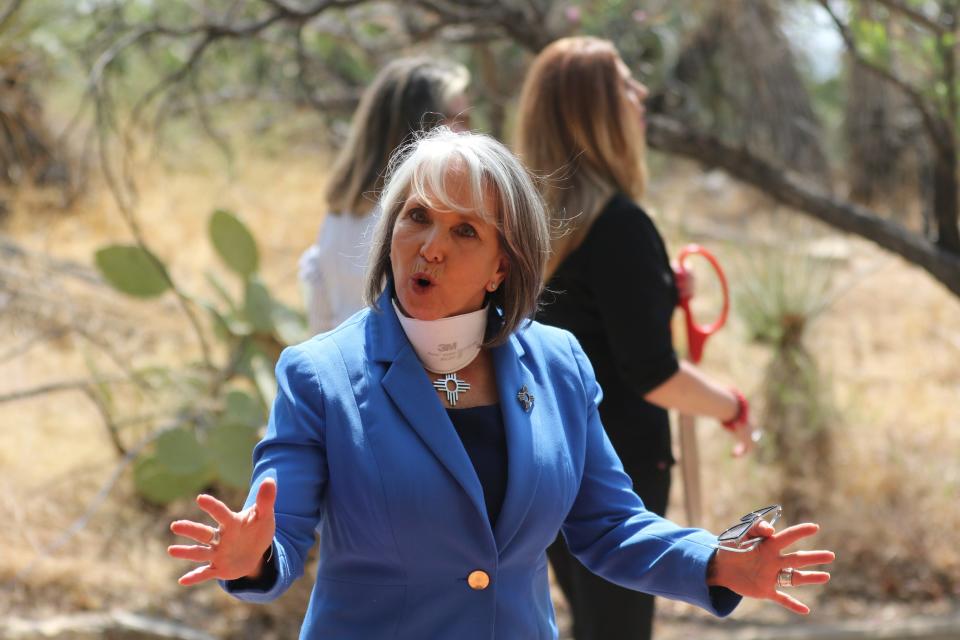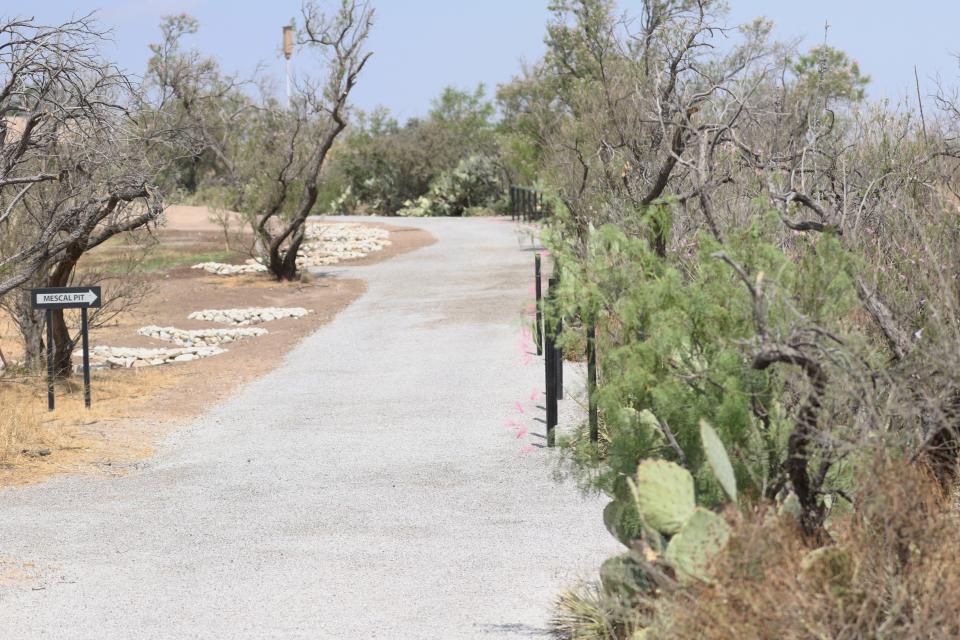New Mexico state parks could prove alternative to national parks closed amid wildfires
Devastating wildfires across New Mexico could have an impact on tourism this summer as restrictions were in place for several popular destinations.
The Calf Canyon Hermits Peak fire burned more than 340,000 acres in northern New Mexico, the largest wildfire in state history. The fire, the result of a prescribed burn that got out of control, led to myriad evacuations in the Sangre de Cristo mountains near Santa Fe, Las Vegas and Taos. The federal government later admitted responsibility and President Joe Biden promised financial help toward recovery efforts.
The Black Fire, which has charred more than 325,000 acres in the Gila National Forest north of Kingston and Hillsboro, would have been the state's largest ever fire if not for the Calf Canyon Hermits Peak blaze. It's suspected of being "human-caused," per a report from the Southwest Area Incident Management Team.
In the weeks since the fire season started the National Park Service and U.S. Forest Service began closing trail heads and other recreational sites on its public lands in New Mexico.
Most of the hiking trails and campgrounds at Carlsbad Caverns National Parks and Guadalupe Mountains National Park were closed as of May 25. The Lincoln National Forest — home to the popular Sitting Bull Falls near Carlsbad — reopened just this week, on Friday.
More: Carlsbad Caverns implements fire restrictions due to high to extreme fire danger
Backcountry camping at White Sands National Park near Alamogordo are closed while hiking and picnic areas are open.
The Gila National Forest has enacted several restrictions due to fire danger.
The closure and restrictions of national parks and forests in the southern New Mexico area this summer could impact a main driver of the area's economy.
In the last five years, between 2017 and 2021, Carlsbad Caverns averaged 391,941 visitors, while Guadalupe Mountains averaged 196,196.
More: New Mexico publishes 5-year plan to leverage federal outdoor recreation dollars
White Sands averaged 604,422 visitors during that time frame.
Restricting access to those parks could drive potential tourism dollars elsewhere.
In 2020 alone, visitors to Carlsbad Caverns spent about $12.1 million in the local community, per study from the National Park Service, while Guadalupe Mountains’ guests spent $9.7 million in the local community and White Sands brought in $22.5 million.
From the mayor: King's Palace tours now available at Carlsbad Caverns National Park

Gov. Lujan Grisham focused on ‘safe tourism’
New Mexico Gov. Michelle Lujan Grisham looked to 35 state parks throughout New Mexico to fill the void created by blazes and fire safety measures.
She said the state had no plans to close New Mexico State Parks amid fire season and would keep them safe using an approach more “measured” that federal agencies, while expecting national parks in New Mexico to reopen soon.
“We have to keep encouraging safe tourism,” Lujan Grisham said in an interview with the Carlsbad Current-Argus. “I recognize the significance pf the federal government that will spend billions on a significant fire that is their fault. I understand their reaction.
More: Proposed changes to hunts for deer, elk and exotic prey open for public comment
“My message to the federal government is we need to be measured. This knee-jerk reaction, we view it as a temporary closure.”
Lujan Grisham pointed to pollution and ongoing climate change as driving extreme weather events like wildfires, as New Mexico was expected by state climate scientists to get gradually hotter and drier in the next 50 years.
“I’m an ardent believer in science at the effects of climate change,” she said. “I don’t think you can describe what’s going on in the West as drought. It’s the aridification of our planet. We have to learn to live in this environment. I think as people get their act together, we will see less severe climate reactions.”
More: 'We need rain': Southeast New Mexico wildfire risk grows as northern region burns

‘Embedded’ in the community
Most New Mexico state parks remained open at the start of summer.
One state park to visit is Carlsbad’s Living Desert Zoo and Gardens State Park, which recently reopened a 1.3-mile trail, upgraded to be accessed by people with disabilities.
The trail takes visitors through mountain vistas of the Chihuahuan Desert, through multiple exhibits of plants and animals native to the area and serves, and also serves as a sanctuary for animals found injured in the wild.
At a recent dedication of the revamped trail, Lujan Grisham said state parks were essential to local economies and to New Mexico’s growing tourism industry.
More: President Joe Biden signs bill to boost New Mexico's outdoor recreation, improve access
“Those properties are incredibly important to the communities in which they reside,” she said. “They’re easy to forget because they are largely supported by the community and private sector. Given that our outdoor recreation sector is doing well and exceeding our expectations, it’s time to challenge ourselves to consider other investments.”
The recent work Living Desert was funded through a $100,000 donation from Chevron, dollars that would go to energy efficiency upgrades throughout the park’s visitor center including a rooftop solar power system.
More: Seasonal help fills void for increased outdoor activities during spring and summer
Toby Valasquez, director of the New Mexico State Parks Division said the state has $20 million in funding for more improvements to state parks from the federal Infrastructure Investment and Jobs Act, a signature piece of legislation passed by Congress and signed into law by Biden last year.
“We truly are embedded in our communities in every corner of the state,” Vasquez said. “We really want to encourage people to get out and enjoy or parks. It increases quality of life.”
State parks in southern New Mexico
Park profiles adapted from descriptions on the New Mexico state parks website. Go to https://www.emnrd.nm.gov/spd/find-a-park/ for more information on each park.
Bottomless Lakes: Located 14 miles southeast of Roswell, Bottomless Lakes State Park welcomes non-motorized boating, swimming, fishing and scuba diving in its sinkholes, ranging from 17 to 90-feet deep. There are also opportunities to camp, picnic, hike and go birding.
Brantley Lake: The southernmost lake in New Mexico, 12 miles north of Carlsbad, offers boating, kayaking, canoeing, fishing, hiking trails, bird watching, developed and primitive campsites and restrooms with showers.
Caballo Lake: Framed against the Caballo Mountains south of Truth or Consequences, this lake boasts an array of water recreation, such as boating, kayaking, canoeing, sailing, swimming, and fishing. Choose from 170 campsites, with plenty of sites with utility hookups for RVs.
City of Rocks: City of Rocks is a geologic formation made up of large, sculptured rock columns, or pinnacles, rising as high as 40 feet. Located about halfway between Silver City and Deming, the park offers camp sites, hiking trails, mountain biking, wildlife viewing, birding, stargazing, picnic areas and a desert botanical garden.
Elephant Butte Lake: New Mexico largest state park is just north of Truth or Consequences. The lake can accommodate watercraft of many styles and sizes: kayaks, jet skis, pontoons, sailboats, ski boats, cruisers, and houseboats. The park offers restrooms, picnic area, playgrounds, and developed sites with electric and water hook-ups for RVs.
Leasburg Dam: A 25-minute drive from Las Cruces is this quiet park along the Rio Grande. The park offers a cactus garden, an observatory, several hiking trails, and opportunities for fishing, canoeing, kayaking and birding.
Living Desert Zoo & Gardens: This native wildlife zoo exhibits more than 40 species of animals and hundreds of species of plants native to the Chihuahuan Desert. The park also has hiking trails, picnic areas and group facilities. There is no camping and no pets are allowed.
Mesilla Valley Bosque: The park is located on the Rio Grande near Mesilla. Visitors have opportunities to view wildlife in natural surroundings while strolling one of the self-guided nature trails.
Oliver Lee Memorial: Set against the Sacramento Mountains, this park features a historic ranch house, quiet camping and the oasis created by pools of water under the cottonwood trees of Dog Canyon. Hiking trails also available.
Pancho Villa: Located in Columbus, at the border of Mexico, the park exhibit hall and historic structures capture the history of the Pancho Villa Raid and historic Camp Furlong. The large campground offers utility hookups for campers with RVs, and a playground for kids.
Percha Dam: This quiet park along the Rio Grande, between Truth or Consequences and Las Cruces, is shaded by tall cottonwoods and provides fishing, camping and bird watching.
Rockhound: The rugged slopes of the Little Florida Mountains, nearby Deming, are the setting for this park, which boasts hiking trails, unique geology, wildflower displays, and a campground.
Adrian Hedden can be reached at 575-628-5516, achedden@currentargus.com or @AdrianHedden on Twitter.
This article originally appeared on Carlsbad Current-Argus: National parks close amid wildfires, New Mexico state parks still open

